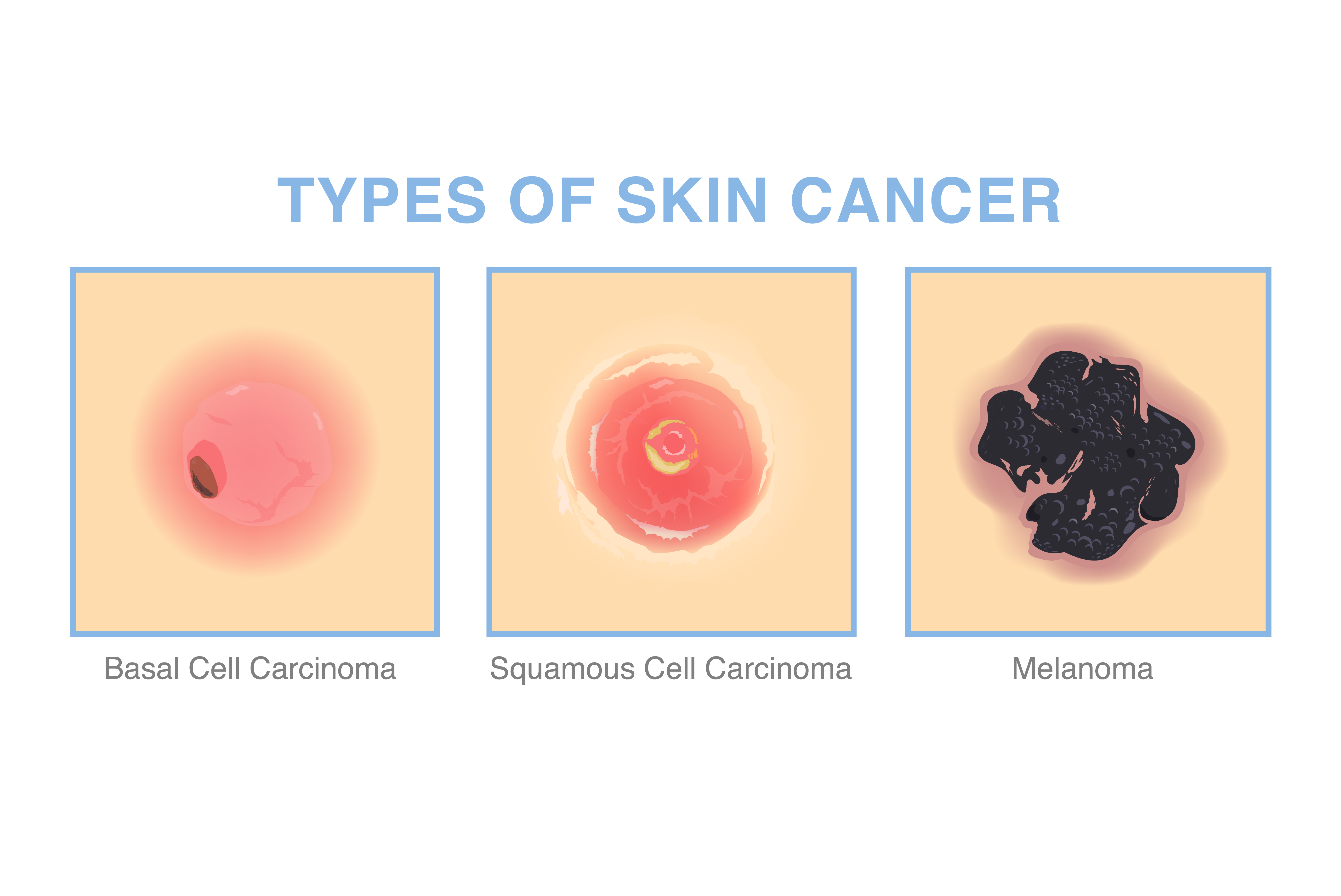Do the words “skin cancer” make you think of melanoma, an aggressive form of the disease that can spread to other parts of the body if not caught early? A melanoma diagnosis can be concerning, but it only affects a small percentage of people skin cancer. For most people, the diagnosis is made slightly less invasively.

The three most common types of skin cancer
- Basal cell carcinoma is responsible for approximately 80% of all skin cancers.
- Squamous cell carcinoma is responsible for almost 20% of all skin cancers.
- Melanoma accounts for less than 3% of all skin cancers.
Basal cell and squamous cell carcinomas are diagnosed much more often than melanoma, but people are more familiar with melanoma because it causes significantly more deaths. If you have melanoma, early diagnosis and treatment usually leads to better outcomes.
The average person who notices something suspicious on their skin cannot tell whether they have melanoma, a less aggressive form of skin cancer, or something non-cancerous. Therefore, you should visit your healthcare provider if you notice any changes in your skin.
Risk factors for skin cancer
The three most common types of skin cancer arise in the outer layers of the skin (the epidermis). Squamous cells are closest to the skin’s surface. Basal cells are located deeper in the skin. The melanocytes – cells that produce the skin pigment, where melanoma arises – are located between the squamous cells and the basal cells.
Skin cancer most often occurs in people who are frequently exposed to ultraviolet (UV) light. Ultraviolet light can damage skin cells, causing cancer. Activities that expose you to UV light, such as sunbathing and tanning beds, increase the risk of skin cancer. Limiting these activities should reduce your risk.
You cannot change certain risk factors for skin cancer. You are at increased risk if you have pale skin or light-colored eyes, if you have many moles or if skin cancer runs in your family.
Taking immunosuppressive medications or biologic therapies that treat conditions such as Crohn’s disease or rheumatoid arthritis may increase your risk for squamous cell or basal cell carcinoma.
How different types of skin cancer affect the body
Melanoma, basal cell carcinoma and squamous cell carcinoma all behave differently in the body.
- Melanoma is the most concerning form of skin cancer because it can grow and spread quickly. It usually occurs on sun-exposed skin, but it can also occur on unexposed areas such as the toes, under a nail, or in the ear canal. Melanoma can spread to the lymph nodes and then to other places in the body. If you treat melanoma before it spreads, the long-term survival rate is significantly higher.
- Basal cell carcinoma is the least concerning form of skin cancer. It usually occurs on skin exposed to the sun. It grows quite slowly and is unlikely to spread to other parts of the body unless left untreated for an extended period of time.
- Squamous cell carcinoma is less concerning than melanoma, but more concerning than basal cell carcinoma. It usually occurs on skin exposed to the sun. It is more likely to spread to other parts of the body than basal cell carcinoma, but it is not as invasive as melanoma.
How skin cancer is treated
If you are diagnosed with skin cancer, healthcare providers will surgically remove the affected area. If you have a small basal cell or squamous cell carcinoma, your dermatologist can remove it during a consultation visit. For melanoma or larger basal cell or squamous cell carcinomas, your dermatologist may refer you to a surgical oncologist to remove the cancer. Surgical oncologists treat larger, more advanced cancers.
What happens next depends on the type of skin cancer you have and how advanced it is.
Melanoma treatments can range from simple surgical excision to more complex surgeries that involve sampling the lymph nodes to see if the cancer has spread. If the melanoma has advanced, patients may receive chemotherapy or immunotherapy.
Some patients with advanced cases of basal cell carcinoma or squamous cell carcinoma may benefit from immunotherapy after surgery. In certain cases, patients with aggressive squamous cell carcinoma may receive radiotherapy.
The importance of early detection
Paying attention to your skin can help you spot changes that could be skin cancer. If any of your moles change color, grow larger, develop uneven edges, or become painful, it may be skin cancer. A suspicious mole is not an emergency that requires a visit to the healthcare provider the next day. It’s fine to make an appointment within a few weeks.
If you notice a suspicious mole and there is no dermatologist there, don’t worry. Primary care providers are trained to assess your skin. In some cases, they may refer you to a dermatologist for assessment.
If your provider is concerned that your mole could be cancerous, they may biopsy it. The test results will confirm whether you have skin cancer and what type it is.
Getting a diagnosis as soon as possible may be the best thing you can do for your health. Finding out you have basal cell or squamous cell carcinoma can come as a relief, as these are less concerning than melanoma. If you have melanoma, it is ideal to find out as early as possible; you can catch it before it spreads.
Arvind SabesanMD, FACS, is a surgical oncologist accepting new patients Helen F. Graham Cancer Center & Research Institute. Call today for more information: 302-658-7533.
 Healthy Famz Healthy Family News essential tips for a healthy family. Explore practical advice to keep your family happy and healthy.
Healthy Famz Healthy Family News essential tips for a healthy family. Explore practical advice to keep your family happy and healthy.


